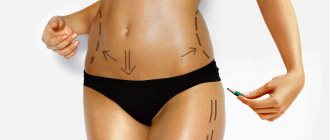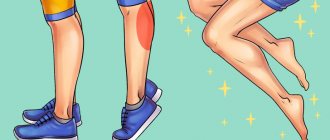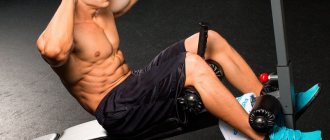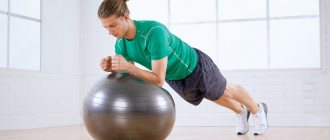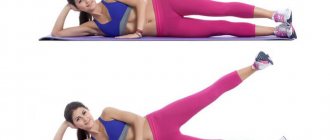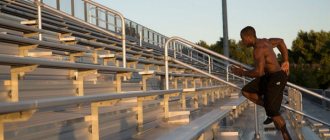A beautiful and high-quality shoulder shape directly depends on a properly developed rear deltoid. It is this bundle of muscle that completes and rounds the shoulder, giving it an athletic shape. Therefore, you should not ignore rear delt exercises. The main condition will be the correct execution technique, number of repetitions and load.
We recommend reading: Sports nutrition for gaining muscle mass for men
Features of bent-over arm raises
Unlike exercises for the posterior deltoid muscle, which are performed in simulators, bent-over dumbbell raises allow you much better , since working with free weights, more muscle fibers are activated, and energy costs increase.
The exercise requires stabilization of the spine, it is important to keep your back straight , due to this the muscles of the back and abdomen are further strengthened.
This technique is suitable for a more prepared athlete, but there is a second execution option available at any stage of training.
The main work is done by the rear delta bundles; in the upper phase, when the dumbbells are abducted in an inclined position, are involved . In addition to the main muscles, the work includes:
- teres minor;
- infraspinatus;
- trapezoidal;
- the teres major and rhomboid muscles also work additionally, which bring the shoulder blades together.
Load distribution depending on the type of swing
First of all, let's figure out which muscles work when performing which swings. This must be understood in order to train your legs correctly.
- Backward leg swings are designed to work the muscles of the hamstrings (hamstrings) and buttocks (gluteus maximus). Moreover, if you swing with a straight leg, the back of the thigh works to a greater extent and the lower back is additionally involved. When you swing with your leg bent at the knee, standing on all fours, you focus the load on the muscles of the buttocks.
- Forward – works the front of the thigh (quadriceps).
- To the side (outward) – gluteus medius muscle.
- To the side (inward) – the inner surface of the thigh (adductor muscle).
It is recommended to combine different types of swings so that the muscles of the thighs and buttocks receive a comprehensive load. At the end of the article, we will analyze in detail the technique of performing each type of swing.
The exercise is absolutely not demanding on equipment. It can be easily done at home. In this case, you can either not use additional equipment at all, or attach weights to your ankles. There are different types of machines in the swing room. These include cable simulators (lower block), and simulators for hip abduction/adduction, etc.
Leg swings are ideal for people with knee problems who are contraindicated for doing squats or lunges. In this case, it is better to do the exercise while standing or lying down, avoiding a position on all fours. In the latter case, the knee still experiences a load - you put pressure on it with part of your own weight.
Option 1: standing dumbbell fly technique
This option is the most difficult , since it does not have additional support, so the exercise should be performed with prepared back and abdominal muscles.
- Place your feet shoulder-width apart, bend your knees slightly, and lean forward until your back is parallel to the floor.
- Keep your back straight at all times, as rounding the spine while lifting weights can cause serious injuries to the lumbar region.
- With your arms freely lowered with the dumbbells, bend your elbows slightly, turning them to the sides.
- Exhale: swing the dumbbells out to the sides, raising your arms to the level of your shoulder joints, elbows facing the ceiling. Don't help your arms by jerking or rocking your back. It is important to make the swing faster at the top, but isolate the rear deltoid from the accessory movements.
- Inhale: in the lower phase, make a slower movement - smoothly lower your arms down.
- When gaining muscle mass, it is recommended to perform from 8 to 12 repetitions of 4 sets.
Equipment
Swings are performed with dumbbells, so you need to select your weight in advance. You can start working your muscles with dumbbells that weigh only 5 kg. Next, it should be increased so that the muscles do not get used to the constant load.
When lifting heavy weights, weightlifters often use athletic belts . They keep the lower back muscles in a stable position, allowing you to focus on the upper back. You can also use elastic bandages for your elbows if you have previously had an injury to this joint.
Option 2: sitting bent over dumbbell fly technique
This version of the swing is performed while sitting, with the stomach resting on the thighs; this helps the athlete concentrate more on the movement of the arms. The emphasis will help you not to think about the position of the spine, but you should not forget about the quality of the technique
- Sit on the edge of a bench, hold small dumbbells in your hands, and lie with your stomach on your thighs. The arms hang freely above the floor, the elbows are slightly bent and turned to the sides.
- Exhale: perform reverse raises of dumbbells through the sides, without lifting the body, the position of the body does not change.
- Inhale: Slower than the upswing, lower the dumbbells down.
- Perform 8-12 times, the lower the load, the more repetitions . Total 3-4 approaches with a rest of 1-2 minutes.
Option 3: Dumbbell swings lying at an angle of 45 degrees
One of the simplified versions of the exercise is performed with the abdomen resting on an inclined bench.
- Set the bench at an angle of 45 degrees, lie down with your stomach on the surface so that your chest lies on the bench. The feet rest on the floor on the sides of the bench, the knees are bent, you can also rest your knees on the seat.
- Hands with dumbbells hang freely, elbows slightly bent and turned to the sides.
- Exhale: perform a quick swing to the sides to the level of the shoulder joints, aiming your elbows at the ceiling.
- Inhale: lower slowly to the starting position.
- It is recommended to perform 8-12 times, 3-4 approaches.
Option with changing the position of the elbows
In any of the bent over fly variations, it is possible to change the technique, this concerns the position of the elbows when lifting. This modification will require more weight , since simplification of the technique will lead to the fact that the working weight of the classic version of the swing will be too small. This option will perfectly increase strength indicators.
- The starting point is below - arms hang down, elbows turned to the sides.
- Exhale: perform a dumbbell swing across the side, bringing your elbows to a right angle, the forearm remaining perpendicular to the floor.
- Inhale: slowly lower your arms to the starting point.
As the technique becomes simpler, you can use the ladder technique , starting the first set with 12 repetitions, and with each subsequent set, reduce the repetitions by increasing the weight of the dumbbells.
Recommendations for men and women
For beginners in the gym, bent over arm abductions with dumbbells can be incomprehensible and difficult to perform, since a person may not feel where and how the rear delta works. Therefore, to begin with, it is recommended to perform arm raises in the simulator; the muscles will become toned within a month, and then they will require a more complex load. Then move on to swings with dumbbells, gradually increasing the weight.
- Men are recommended to perform delt exercises no more than 2 times a week for 8-12 repetitions.
- For girls, it is enough to train their shoulders once a week, 15 repetitions, 3 sets.
How to pump up your rear deltoids | Complete Guide
9 rear delt exercises to gain mass
Have you noticed that the muscles of the front part of the body are always ahead of their rear counterparts in development? For most gym goers, the hamstrings lag behind the quadriceps, the back lags behind the chest, and the triceps lag behind the biceps. And it's all the mirror's fault. Those muscles that we don’t immediately see when we look at ourselves, seem insignificant to us and are trained on a residual basis. Especially when they are still small in size and grow poorly, such as the posterior bundle of the deltoid muscle. Therefore, the topic of my article today will be to find answers to the questions: how to pump up the rear deltoid, how to avoid mistakes in its training, and what exercises should be used for this.
Having spent a huge amount of time in the gym, I can’t say that the rear deltoid is not pumped up. On the contrary, everyone who wants to have shoulders like balls trains this small bundle of deltoid muscles quite actively and regularly. But not everyone succeeds in pumping up the rear deltoid by working according to the generally accepted shoulder training scheme. And there are five very good reasons for this:
We recommend reading: Push-ups for pectoral muscles for men technique
Reason 1. The rear deltoid is lazy
According to a 2002 study, an amateur bodybuilder's anterior deltoid muscle mass is almost 5 times greater than that of an average person. The average beam is 3 times larger, but the rear delta is only 15-20%. The reason for this injustice lies in the fact that the front delta takes an active part in all pressing exercises for the chest/triceps/shoulders, and the rear delta is practically not included in the work during basic exercises.
Over time, the anterior deltoid becomes the largest and strongest bundle of the deltoid muscle and begins to openly steal the load when performing most of the pressing movements from other muscles. Its activity, along with the passivity of the posterior delta, is the main reason for the chronic lag of the posterior bundle in volume.
The front delta is actively involved in all pressing movements, overtaking other muscles in mass and strength.
Reason 2 . The rear deltoid is pumped incorrectly
Of course there are exceptions, but in most people the muscle fibers that make up the deltoid muscle are slow-twitch. This means that you won’t be able to pump up your rear deltoid by swinging heavy dumbbells and performing 6-8 repetitions per set. Exercises for it need to be done with a much larger number of repetitions, without hesitation in using very modest working weights for this. High repetition work, 12-15 and even 20 repetitions in each set - this is a sure way to pump up the rear deltoid.
Calculate your ideal sports weight!
Reason 3. It’s difficult to target the rear deltoid
The smaller the muscle in volume, the more difficult it is to involve it in work and make it grow. We are accustomed to thinking that the deltoid muscle consists of three separate segments: anterior, middle and posterior. But as science says, in this group there are 3 main and 4 auxiliary bundles of muscle fibers, which means that it becomes even more difficult to direct the load exactly to the address and pump up the rear delta by performing only classic exercises.
If the front delta takes most of the load from the middle one during overhead presses, then the trapezius also does so during exercises for the rear delta with a barbell and dumbbells. Especially when, in training the rear deltas for mass, the weight of the weight is inadequately selected.
Incorrect technique for performing exercises on the rear deltoid transfers the load to the trapezius
Reason 4: Train your rear delts last.
No matter what anyone says, we get true pleasure from working out in the gym by pumping up our favorite muscle groups. They are a source of pride for us, so we give priority to their development. Now the question is: who likes to pump up the rear delt? Especially when it doesn't grow at all. The answer to this question will be another reason for its lag.
To increase the volume of the rear deltoid and make it a source of pride, shoulder training should begin with it, and then move on to exercises for the middle beam. In addition, no matter how much we would like to isolate the rear deltoid, it is simply impossible to exclude its middle sister from work. During training on the mass of the rear deltoid, the middle beam will also receive sufficient load. You can safely start a set of shoulder exercises with exercises for the rear delta and the growth of the overall muscle mass of the shoulder girdle will only be beneficial.
